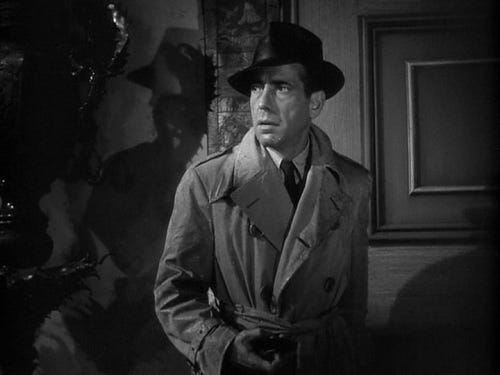
Picture a small, dimly lit office overlooking an urban jungle. The room washed with cigarette smoke and the smell of cheap Jim Beam strong enough to drive a bloodhound mad. In the middle of the room, a small desk littered with unopened mail reading “PAST DUE'' and spent butts in an ashtray. It’s a hot summer night where we find a man sitting by his lonesome at the desk as he fans his drenched round face with the morning newspaper.
In from the office door comes a young woman. She shuffles her way in the room keeping her purse close to her. Her eyes are blue and cold.
She walks up to the desk, pulls out an envelope fat with cash, and tosses it to the man. He counts the money bill by bill just to be sure.
The man nods to confirm. He reaches for his dusty blazer and fedora as he follows the woman out. Closing the door behind him that reads “Detective Agency”
I wrote the scene above to demonstrate a few similar elements that are often repeated in classic American crime fiction. Stories beginning in an office with a lone detective hired for a job only he can do. Stories filled with hard liquor, seedy characters, deceitful dames, and violent crime were more than common. Although now they may be cliches, these elements of static characters and grittiness are universally recognized for their imagery and influence.
The first installment of this series covered a quick 101 on the lasting legacy of the Pulps in American pop culture. In Part II, we’ll take a deeper dive into a genre that built writing careers and paved the way for a new kind of detective.
From Dupin to Marlowe
The first detective story published, “The Murder in the Rue Morgue”, was written by Edgar Allen Poe 1 and introduced his gentleman detective, C. Auguste Dupin, who usually solved crimes as a means to occupy his free time. Dupin would go on to influence other detective stories written by esteemed authors, such as Charles Dickens and Wilkie Collins. Poe’s character would lead to the rise of the popular consulting detective archetype, with eccentric characters like Sherlock Holmes created by Sir Arthur Conan Doyle.
Holmes and other gentlemen detectives such as Agatha Christie's Hercule Poiroit became household names and continue to be read by millions around the world. Whodunits and Locked Room mysteries often went hand in hand with these characters, who would rely on deductive reason and logic to solve their crimes.
Then came the Pulps.
Between 1920 until the end of the 1940s, American crime fiction offered a stark contrast from the eccentric gentleman. Pulp fiction offered realism at the highest order. Magazines were filled with raw violence, sex, and corruption set against the backdrop of American city streets. These detectives were not gentlemen; they were ball-busting, hard-drinking, gun-toting static men that played rough. Instead of deductive reason, they relied on their fists and street smarts to get them out of trouble. Solving crime was a way to make an honest living to them, not a leisurely activity to occupy a Sunday afternoon.
The hardboiled detective was born.
America already had popular crime pulps beginning with the 1915 “Detective Story Magazine.” Thirty years following, the publication included known pulp writers such as Carroll John Daly (Race Williams series) and Johnston McCulley (Zorro). 2
The most notable magazine was “Black Mask” which ran from 1920 until 1951 that not only introduced celebrated characters, but also built careers of Carroll John Daly, Erle Stanley Gardner (Perry Mason), and Dashiell Hammett (The Continental Op). These three writers made their bones with the pulps and helped carve out the hardboiled detective genre. (2)
These detectives, also known as gumshoes, didn’t shy away from violence to get the information they needed. Brawling thugs for interrogation and even shooting the main villain were not out of the question. These men of action did what needed to be done, not only to dispel justice, but to keep the lights on at home. No gumshoe was going to turn away cash, especially during the times of Prohibition and the Great Depression.
Often novels were serialized in the pulps. The Maltese Falcon, Hammett’s most famous novel, ran between 1929 until 1930 for “Black Mask” (2) and later inspired the film starring Humphrey Bogart.
The hardboiled detective took the country by storm with high demand from loyal readers and the pulp writers were happy to comply by churning out regular short fiction and novels. Chandler’s Philip Marlowe and Hammett’s Sam Spade ushered in a new era that would lead to other characters like Mickey Spillane’s Mike Hammer and Walter Mosley’s Easy Rowlings keeping the tradition alive even to this day.
The Slicks and The Silver Screen
If it’s one thing I want to hammer home for readers of this post it’s that the Pulps, although looked down on as hack work by many people, they often served as the training ground for many esteemed writers in history. It was not uncommon for pulp writers, after much success in writing for the magazines, to venture into Hollywood to become screenwriters.
James M. Cain wrote many hard boiled novels that were later adapted into several feature films such as The Postman Always Rings Twice and Mildred Pierce. My favorite of Cain’s works has to be Double Indemnity, a novella about an insurance agent who is seduced by a married woman to kill her husband and collect the insurance money. It’s a great short read that hits all the right beats in American crime fiction. Highly recommend it. The 1944 film starring Fred MacMurray and Barbara Stanwyck is a real treat too. The screenplay was penned by Billy Wilder and Raymond Chandler, whose first novel The Big Sleep was also adapted to the screen. Funny enough, the script for The Big Sleep was penned by novelist William Faulkner, Jules Furthman, and pulp writer turned “Queen of Space Opera,” Leigh Brackett.
These films demonstrated the gumshoes’ black and white morality in a constant gray world filled with untrustworthy characters. Although many of these were categorized as Film Noir, you can see much inspiration and creative license with character such as the fedora wearing man of action and the sultry femme fatale derived from the magazines like “Black Mask”.
Case Closed
If you're looking to get your hands on some of the crime pulps, there is a wealth of options for you.
Classic magazines, such as “Detective Fiction Weekly,” can still be found today if you’ve got the serious coin to spend. Other cost effective alternatives include purchasing from known publishers such as Hard Case Crime that not only publish certain reprints, but also contemporary writers such as Max Allan Collins, Lawrence Block, and even Stephen King.
Whether you find gems at your local library, independent bookstore, or eBay, no time will be wasted revisiting these classic stories.
So pour yourself an old fashioned in your comfy leather chair and crack open a copy of a pulp fiction magazine.
“Detective Story.” Edited by The Editors of Encyclopedia Britannica, Encyclopedia Britannica, Encyclopedia Britannica, Inc., https://www.britannica.com/art/detective-story-narrative-genre.
Hulse, Ed. “Gumshoes, Gangsters, and G-Men: The Crime Pulps.” The Blood 'N' Thunder Guide to Collecting Pulps, Murania Press, 2007, pp. 96–136.




An honor to be mentioned in this fine write-up.
Absolutely loved it, Frank. Right up my (Nightmare) alley.